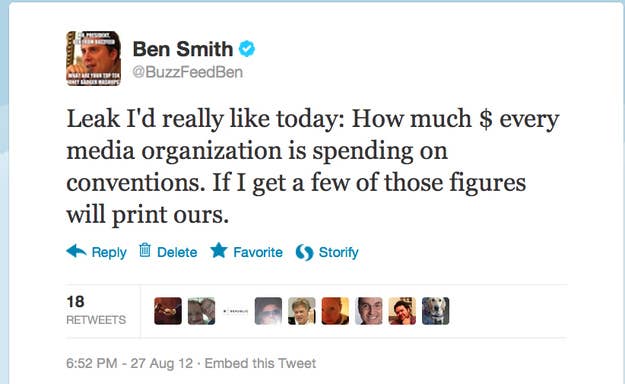
Political conventions represent, for many media organizations (including BuzzFeed) among the most expensive weeks of the year. We fly reporters down to places like Tampa, put them up in hotels specially priced for the convention, and pay thousands of dollars for modest workspaces nearby with electricity and Internet connections.
The sheer scale of this caught my eye on arrival, and I poked around (mostly in vain) for leaks on how much news organizations spent:

Leaks were not immediately forthcoming, but I did pick up a couple of interesting figures yesterday. The New York Times's Jeremy Peters reported yesterday that Bloomberg spent more than $1 million on its "Bloomberg Link" space.
And a CNN employee says the cable channel spent about twice that — $2 million — on the CNN Grill, the lavish, central convention clubhouse.
None of the organizations disclosed their spending. "Good hosts don't talk about how much the party costs," said Huffington Post spokesman Rhoades Alderson.
There's a more-than-reasonable debate over whether political conventions are overcovered, or perhaps simply overdone: The official infomercial is pre-chewed non-news. But they're also a great opportunity to understand a party by talking to its gathered rank and file; to understand and question important party figures; to source up; to report on the influencers who also follow the party camp; and, of course, to cover the media. You can see our extensive coverage, a mix (like politics itself) of the serious and the silly, here.
But those newsgathering costs — including workspaces ranging from lavish to, in our case, quite bare bones — weren't the biggest numbers.
The major reason for the expense isn't newsgathering: It's marketing. News organizations last week in Tampa sought to project their brands with destinations: The Huffington Post Oasis and Politico Hub, along with the CNN and Bloomberg venues. These were all impressive operations: HuffPost's was a spa; Politico's hosted a series of newsy political events; and Bloomberg's high-minded, white-carpeted, and less newsy policy talks. But the CNN Grill — a standard convention feature — was the most impressive of them, the sort of clubhouse for the media and political class right between the Tampa Bay Times Forum and the media center, it was a full-scale sort of political sports bar constructed for free in a parking garage, complete with wood floor, full — and open — bar, free food, and giant screens.
I'm hardly one to sneer at this. Those four outlets are among the ones finding ways to make money while doing serious journalism. And along with enjoying CNN's hospitality, BuzzFeed — which is also making smart, serious, and silly social content into a sustainable business — also spent money on marketing: More than $20,000 on a party at the Florida Aquarium aimed at celebrating our arrival as a major political news outlet and at meeting IRL some of the sources and competitors we know from the social web.
What those eye-popping numbers really show is something about the conventions' identity: They's a strange and at times uncomfortable collaboration between a political party and the media, with news organizations investing heavily in shaping their own identities, just as the political parties are. They are, perhaps, best seen as media conventions; and modern political campaigns are, after all, first and foremost media organizations themselves.
